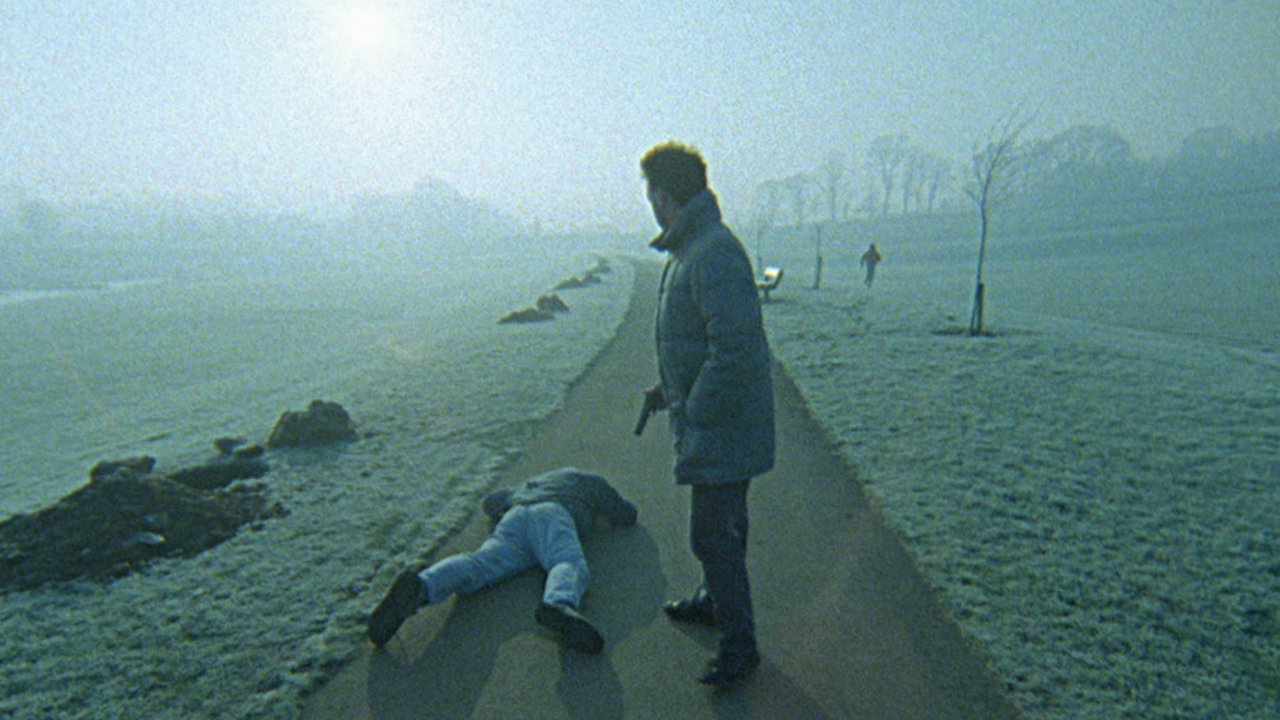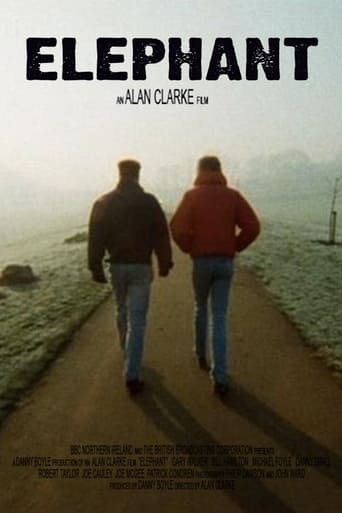

The recurring action of "Elephant" consists of the camera closely following someone walking down a small path and then shooting other person, then the camera stays there with the victim for a little while. This goes on and on for about 40 minutes, and that's the whole movie. Pounding our minds with this cold-blooded, disturbing and unexplainable scenario, barely containing any dialog and not giving any reasons behind those acts, director Alan Clarke and his last film deals with 'the troubles' in Northern Ireland but it also seems more than just that. One can view it with a wider perception. Why such title? It comes from Bernard MacLaverty's description of the troubles as "the elephant in our living room", a reference to people's denial of the underlying social problems of Northern Ireland. But since no one's talking and the images are so powerful and universal, we can picture this as happening outside of Ireland, since the violence problem hits everywhere and almost everyone.But what Clarke wanted to cause on us with those images? To desensitize us or to show that such can't be done at each single scene? The reflection is there for everyone to see, yet most of us we'll only consider "Elephant" as being repulsive, shocking, tasteless or pointless. By presenting things very randomly, he hits harder and with more brutality than any violent film ever made in that same decade. It's the shock of never knowing who's going to be the new victim or where the new attack is going to happen and most of all, why they are happening. We're there just as watchers, mere passers by looking at something unusual and frightening happening in front of us. It could have been a reason behind all the murders but it's invisible, hidden from us. It is said that the director re-enacted those from similar real events that took place in his country, terrorist attacks related with the troubles. The penetrating, repetitive, poignant, insisting image doesn't comes from the act of violence but the everlasting effect of such. The dead bodies, lying on the ground. It is as if Clarke was trying to capture the soul getting out of the body or just waiting for a sign that they could have survived the brutal attacks they were victim of. No. It's a way of reminding us that a few seconds earlier someone was breathing, living, doing something and all that moment was gone. Why? But why? Because of something unimportant, small and even maybe a case of being at the wrong place, at the wrong time, crossing someone who needed to kill someone. Clarke wanted to show the banality of life, testing on us the effect all the murders would have on us.With this silent criticism where only a gun being fired was the only voice who said a thing echoing for a long time, this is a haunting and unforgettable picture, and inspired another great "Elephant", the one directed by Gus Van Sant, who heavily worked on the same principle (criticism, shot compositions) but treating in the form of the Columbine incident. Both remarkable works. 10/10
... View MoreThe film is made up of 18 short films, showing unjustified killings. In each part of this strange thriller, a murderer and a sacrifice and usually but them in the shot no one.The painting "Elephant", is filled with a cold, so a neutral atmosphere. If from what you can get here is a pleasure as the mood of the film. All shorts are designed in one color, unrelated, they still look very harmonious.This film may be a benefit for young filmmakers to make films, in which there are scenes of murder.Of course, if you look at the film with plenty of imagination, it can be to make up the history of each murder, thereby determining why it happened.After a while, after this film, there is a picture of Gus Van Sant, going by the same name. There definitely is a connection there, because in one of the interviews himself Van Sant said that after watching the "elephant" Clark, he wanted to withdraw his "Elephant." I think he is right and is the spectator Clark, who watched this movie with plenty of imagination. That imagined Van Sant, the mass murder at the school, and quite original show cause, not as pure, but the name speaks for itself, the problem is definitely there, it is just in the minds of others, there is much we would not get. Both elephants, a very similar atmosphere that captivates the viewer, who manages the end to inspect these movies.
... View MoreI saw this film when it first came out and remember it so clearly. The film shows the executions in such a matter-of-fact way. No background swell of music. A loud bang or two. Shocked silence broken only by footsteps walking purposefully away from the scene. I was two streets away from the Guildford bombs when they went off in 1974. I remember I finished my pint before going to see what had happened - I guess I was young, then, but there was a feeling of acceptance amid the shock. We all knew what had happened. It was on the television constantly. As my friends and I approached the Horse and Groom the shouting was just starting. And then the sirens, but those very few minutes of silence after the bangs were the loudest of my life. This film showed what it was like.
... View MoreI already gave my comments as Bart-53. Gus vanSant made my day by putting this movie as a feature on his DVD by the same name (Elephant). It was quite a few years ago that I saw this movie on TV and I have regretted ever since that I did not tape it to VHS as I had done with all the other films by Alan Clarke (the BBC showed most of his movies over a period of some weeks). Other beauties by Alan Clark are Scum (introducing Tim Roth) and The Firm (introducing Gary Oldman). I thought I would never see this movie ever again until I recently rented Gus vanSant's Elephant. According to the interview with him, which is also a feature on his DVD, he was made aware of Alan Clarke's movie by a friend. Gus vanSant's Elephant is an entirely different movie (based on the Columbine killings), but he was definitely influenced by Alan Clarkes style of filming (long steadycam shots in which we follow characters). Although the topic is no longer an issue (Northern Ireland killings) this is still a must-see movie.
... View More